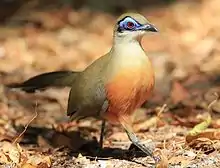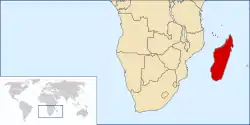Coua
Couas are large, mostly terrestrial birds of the cuckoo family, endemic to the island of Madagascar.
| Couas | |
|---|---|
 | |
| Coquerel's coua (Coua coquereli) | |
| Scientific classification | |
| Kingdom: | Animalia |
| Phylum: | Chordata |
| Class: | Aves |
| Order: | Cuculiformes |
| Family: | Cuculidae |
| Genus: | Coua Schinz, 1821 |
| Species | |
|
See text | |
 | |
| range of genus | |
Reminiscent of African turacos when walking along tree branches, they likewise feature brightly coloured bare skin around the eyes. Some resemble coucals in their habit of clambering through plant tangles while foraging, while the arboreal species move between tree canopies with gliding flight. Four species occur (red) in rainforests while the remaining six are found in the dry forests of western and southern Madagascar.
They have large feet, with a reversible third toe like all cuckoos. Their long tibia suggest a relationship with the Carpococcyx ground-cuckoos of Asia, a genus with similar nestlings. Consequently, they are sometimes united in the subfamily Couinae.[1] Couas build their own nests and lay white eggs. Couas' calls are short series of evenly spaced notes, which are sometimes answered by other individuals.
Taxonomy
The genus Coua was erected by the Swiss naturalist Heinrich Rudolf Schinz in 1821 with the giant coua (Coua gigas) as the type species.[2][3] The name is from koa, the Malagasy word for the couas.[4]
Species
There are nine extant species placed in the genus:[5]
| Image | Scientific name | Common Name | Distribution |
|---|---|---|---|
.jpg.webp) | Coua cursor | Running coua | Madagascar. |
_(9616274364).jpg.webp) | Coua gigas | Giant coua | western and southern Madagascar |
 | Coua coquereli | Coquerel's coua | Madagascar. |
| Coua serriana | Red-breasted coua | Madagascar. | |
.jpg.webp) | Coua reynaudii | Red-fronted coua | Madagascar. |
 | Coua ruficeps | Red-capped coua | Madagascar. |
_-_Weltvogelpark_Walsrode_2013-08%E2%80%94130718_0206.jpg.webp) | Coua cristata | Crested coua | Madagascar. |
 | Coua verreauxi | Verreaux's coua | Madagascar |
_-_Weltvogelpark_Walsrode_2013-04.jpg.webp) | Coua caerulea | Blue coua | Madagascar. |
Fossils and Extinct species
- Ancient coua, Coua primaeva – prehistoric
- Bertha's coua, Coua berthae – only known from Holocene fossil remains[6]
- Delalande's coua, or the snail-eating coua Coua delalandei – extinct (late 19th century)
References
- Payne, Robert B., and Karen Klitz (1991). The Cuckoos. Oxford University Press. p. 27. ISBN 0-19-850213-3.
- Cuvier, Georges; Schinz, Heinrich Rudolf (1821). Das Thierreich, eingetheilt nach dem Bau der Thiere als Grundlage ihrer Naturgeschichte und der vergleichenden Anatomie (in German). 1. Stuttgart und Tübingen: J.G. Cotta'schen Buchhandlung. p. 661.
- Peters, James Lee, ed. (1940). Check-list of Birds of the World. Volume 4. Cambridge, Massachusetts: Harvard University Press. p. 64.
- Jobling, James A. (2010). The Helm Dictionary of Scientific Bird Names. London: Christopher Helm. p. 120. ISBN 978-1-4081-2501-4.
- Gill, Frank; Donsker, David, eds. (2019). "Turacos, bustards, cuckoos, mesites, sandgrouse". World Bird List Version 9.2. International Ornithologists' Union. Retrieved 20 July 2019.
- Goodman & Ravoavy; Smithsonian Institution (1993). Proceedings of the Biological Society of Washington. 106. Smithsonian Libraries. [Washington : Biological Society of Washington]. pp. 26–33.
- Birds of the Indian Ocean Islands, Sinclair and Langrand, 1998. ISBN 1-86872-035-7